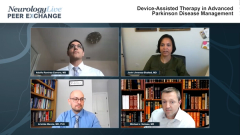
Gastroparesis in Advanced Parkinson Disease
Considerations of gastroparesis in patients with advanced Parkinson disease.
Episodes in this series

Adolfo Ramirez-Zamora, MD: There are some challenges as well when there’s absence. We don’t have a biomarker that tells us where the disease is, where we are in the disease progression, or something we can monitor. We rely on interviews with patients and collateral information about how they’re doing with their quality of life. How much attention do you pay to the concern about gastroparesis? There has been some discussion in recent years about how if somebody is having prominent fluctuations, is it just because the problem is in the gut? Do we need to treat H [Helicobacter] pylori, do we need to give you probiotics, do we need to give you high doses of vitamins, or do we need to do a study to see if your gastrointestinal tract is moving too slowly, and maybe all your pills are sitting in the stomach for a few hours? Do you incorporate that in your practice, Ari?
Aristide Merola, MD, PhD: That’s a great point. Patients read and receive a lot of information, and sometimes too much information can be difficult to digest. But there are a couple of factors that are important. The first factor is protein sensitivity. If they take the levodopa together with animal protein, the absorption of levodopa might be reduced. So they’re educated to take the pill either 30 minutes before or at least 1 hour after a meal, which is OK if you take pills once or twice a day. But when you have to take pills 6 times a day, it can become a little bit tricky. Sometimes I have patients doing crazy things, like skipping meals because they’re terrified that they’re not absorbing their levodopa.
A second point is the gastroparesis. We know that the entire digestive system contains a lot of dopaminergic neurons, and these dopaminergic neurons degenerate in Parkinson. A degeneration of the dopaminergic neurons can also cause delayed transit through the bowel, and this can cause a reduction in the absorption of levodopa. What can we do? Each of us has his own little tricks. I recommend drinking a coffee, or maybe some Coca-Cola. Sometimes it helps. But these tricks, to be totally honest, are just tricks. What I personally do is when I really believe that we’re dealing with a problem of absorption, I try to move to a device-aided therapy. I also have to say that right now, there are extended-release formulations of levodopa, which is not the classical carbidopa-levodopa extended release. There are newer formulations, and some other new [formulations] coming out, which probably makes this a little less critical and important.
Finally, we lack a biomarker, so we have to rely on our patients. I have to say that Parkinson patients are pretty reliable. If we provide them adequate education, once they understand the basic pharmacodynamics of levodopa, they can keep pretty good track of their symptoms. But an entire new generation of digital outcome measures are coming out; a new generation of apps, smart watches, and other devices that can also help with tracking a little—how the tremor is going, how the motor fluctuations are going of dyskinesia. This is still very up-and-coming. We try to incorporate this in our clinic. Some apps are better than others, but it’s still something that probably has to improve a little more.
Adolfo Ramirez-Zamora, MD: Those are great points. I’m glad you brought up some of the newer devices because it’s a hot topic lately. There’s a lot of interest in developing new technologies that will keep track of everything we do, including motor fluctuations or changes in Parkinson symptoms.
Thank you all for watching this Neurology Live® Peer Exchange. If you enjoyed the content, please subscribe to our e-newsletter to receive upcoming Peer Exchanges and other great content right in your in-box. Thank you so much.
Transcript Edited for Clarity
Newsletter
Keep your finger on the pulse of neurology—subscribe to NeurologyLive for expert interviews, new data, and breakthrough treatment updates.

































